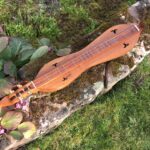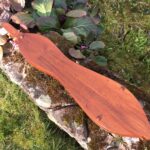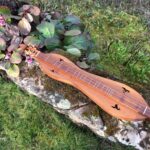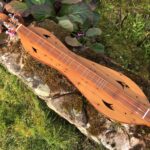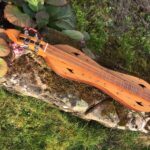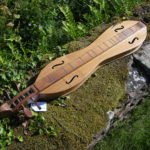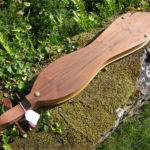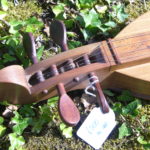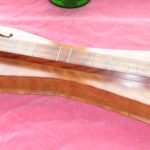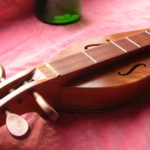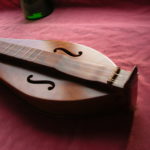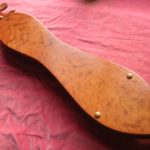Mize Dulcimers
Robert “Bob” Roy Mize (1921-2003) was born in Clayton, Georgia but moved to Blountville, Tennessee. He started building dulcimers when his son Stephen came home from a craft fair with a kit made by Homer Ledford. Homer encouraged the tyro dulcimer builder and offered constructive comments on sound and construction with Bob’s early efforts. Mize began his dulcimer business in 1967, assisted by his wife Mamma Maude and, after her death in 2001, by his children. In the ensuing 36 years, he produced over 3,800 instruments. Most of the instruments were built to customer orders, with the buyer choosing from maple, cherry or walnut, or exotic woods such as bubinga, paulownia, koa and others. His dulcimers have a reputation for quality timber (his stock was the envy of other luthiers), fine craftsmanship and full, rich sound – and are much sought after as a result. Mize built dulcimers for the Tennessee governor‘s office, which gave them as gifts of state to foreign dignitaries. His instruments are in the collections at the Smithsonian Institution and the Tennessee State Museum.
The design is distinctively Mize’s own. It has the classical hourglass proportions, with F or S shape soundholes in both bouts. Top and back have protruding “fiddle” edges. There are three wooden button feet for the instrument to stand on. The headstock has the tapering “scroll” of the Ledford, but a longer pegbox and matching longer, elegant rosewood pegs. The tail stock is also reminiscent of Ledford, set up primarily for ball end strings, with a short span to the floating wooden bridge. The fingerboard is wide and set up for three course double melody or four string equidistant playing.
3.101 1993 Robert Mize Hourglass 4 string 3 course #3048 £395 + £25 robust padded soft case
As 3.102 below, but f/s/ LB label reads “1993/3048”.
Body and top are made from a rich brown mahogany-like wood which the original guarantee card describes as Andiroba. Andiroba is a tall central/south American tree whose wood is similar in colour and grain to Honduras Mahogany, though heavier and stiffer. The wood is bookmatched on back, sides and top, with some delightful grain and lighter sapwood tones…but also a few small shakes. Soundholes are hummingbirds, smaller on the upper bout. Usual elegant Mize scroll and pegbox, comprising a three layer andiroba sandwich, and fitted with Gold enclosed Grover tuners. Bone nut and bridge (latter not compensated), cut for 3 or 4 string layouts. Hollow andiroba fingerboard with original 6+ and 13+ frets. Wooden feet on back. Overall length 35”, upper bout 5½”, lower bout 6¾”, height 1⅞”, FBW 1⅝”, VSL 26¼” (shortish scale), weight 2lb 05oz (1052g), strings now 0.012/[0.012], 0.014, 0.024w. Original 6+ and 13+ frets.
A beautiful-looking instrument with a rich colour and grain and, as always with Mize, sturdy and well-constructed. Its heft does limit its volume a little, although the tone is clear, pleasant and quite warm. Sounds much fuller when you play it on a table, raised up off the surface with its wooden feet. As with its pair #3050, the upgrading of tuners and additional frets do not change what is essentially a traditional-style dulcimer in terms of both sound and intonation. Sounds more at ease in DAA, though works perfectly well in DAD. Action is low and, with its short scale, makes for a very playable dulcimer.
Click on images below to enlarge.
3.102 1993 Robert Mize Hourglass 4 String 3 Course #3050 £Sold
Small square of paper pasted into f/s LB soundhole – “1993/ 3050 [h/w]”. Also very small label inside f/s UB soundhole: “Mize Dulcimers/ 690 Cross Community/ Blountville, Tennessee 37617/ [Tel. No.]”. “Mize” also stamped onto fingerboard between nut and 1st fret.
Body is walnut, bookmatched on the back and with a touch of lighter sapwood at the centre. Top is bookmatched wormy chestnut, with elegant slant arrow soundholes. Scroll and pegbox is constructed as a three part walnut sandwich, in Mize’s long-standing shape, and fitted with nickel Grover enclosed guitar tuners. Hollow walnut fingerboard with 6+ and 13+ frets (no overlay). Traditional high tail, slotted horizontally with string holes for ball-end strings. Bone bridge and nut, both slotted for either conventional 3 course or equidistant 4 course layouts. Three wooden feet to raise the back off a table and increase sustain/volume/bass. Overall length 35”, upper bout 5½”, lower bout 6¾”, height 1⅞”, FBW 1⅝”, VSL 26¼” (shortish scale), weight 2lb 03oz (988g), strings now 0.012/[0.012], 0.014, 0.024w. Original 6+ and 13+ frets.
Good sustain and tone, without huge volume. A mellow dulcimer which plays well to the top of the scale on the melody string, with clear definition. Plays really well in DAA, as with most traditional-style dulcimers, with slightly compromised intonation at fret 1 in DAD.
Click on images below to enlarge.
3.70 1971 #702 4 string equidistant hourglass £Sold
Lacquered-in label or wood sliver (?) ¾ x ½ written in biro: “1971/ #702/ [monogram]“. Gold label seen through UB farside soundhole: “DULCIMERS/ Robert R. Mize/ Route 2/ Blountville, Tenn.” Fingerboard branded “Mize” between nut and 1st fret.
Fiddle-edged walnut sides and bookmatched walnut back, showing some colourful sapwood, with three domed feet. Sassafras (oak/chestnut??) top with f-holes. Elegant walnut headstock and delicate spoon-like rosewood pegs. Walnut fingerboard with slightly off-equally tempered fretting. No 6+ fret. Rosewood nut and movable (?) bridge; high tailpiece undercut on far side to take ball and strings.
Overall length 34½”, upper bout 5½”, lower bout 6½”, height 1⅞”, FBW 1½”, VSL 26½” (short/medium scale), weight 1lb 14oz (851g), strings now 0.013, 0.013, 0.013, 0.028w. No 6+ fret.
Slightly less resonant than some Mizes – perhaps because it’s quite solidly built and heavy. Still, beautifully built and sweet.
[Now SOLD] #1682 has a highly figured, bookmatched top and back. Sides, headstock and tailpiece look like cherry, and there is a remarkable consistency/harmony of colour across the components parts. It is likely therefore that the beautifully quilted top and back are cherry also. The fingerboard is slightly darker but is also attractively figured. Overall length 34⅞”, upper bout 5½”, lower bout 6¾”, height 2”, FBW 1⅝”, VSL 26¼” (short scale), weight 2lb 5oz (1053g). No 6½ fret.
This is a comparatively rare and beautiful dulcimer with unusual depth of tone. The action is straightforward on a shortish scale length and the intonation good. It is classically proportioned and built with a superb eye for detail. Recommended for any serious dulcimer enthusiast.

